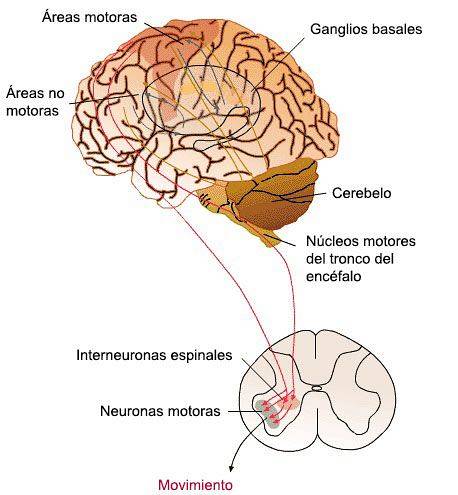
Functioning of the human motor system

The motor system is the part of the central nervous system that is responsible for movement.
Much of the brain and nervous system are dedicated to processing sensory information, to build detailed representations of the external environment.
Through vision, hearing, touch, and the other senses, we perceive the world and interact with it. However, all this processing would have very little value if we did not have an effective way to act on it..
In some cases, the relationship between sensory input and motor output is simple and straightforward; for example, touching a hot stove causes an immediate withdrawal of the hand. But, in general, our actions are conscious and require not only sensory information but also a large number of different cognitive processes that allow us to choose the most appropriate motor production at each moment. In any case, the final movement is a set of orders for certain muscles in the body to move in a certain way..
Motor behavior is one of the most important ways of expressing people. All behavior, whether conscious or unconscious, is based on a set of muscle contractions orchestrated by the brain and spinal cord..
Contents
- Characteristics of the motor system
- Voluntary movement (reading, playing the piano, etc.):
- Reflex responses (withdrawal of hand when touching a burning cup):
- Rhythmic motor patterns (walking, running, chewing, etc.):
- The motor system receives constant sensory information
- Double organization of the motor system: hierarchical and parallel
- Primary or alpha-type motor neurons of the spinal cord and brainstem:
- Brain stem
- Cerebral cortex
- The basal ganglia and cerebellum
- Cerebellum
- Basal ganglia
Characteristics of the motor system
The motor system is characterized by receiving constant sensory information and presenting a double organization: hierarchical and in parallel..
Our motor system can do three types of movement:
Voluntary movement (reading, playing the piano, etc.):
- Movements directed at a specific motive or purpose.
- Your execution improves with practice.
- They may or may not occur in response to an external stimulus.
Reflex responses (withdrawal of hand when touching a burning cup):
- Rapid, stereotyped and involuntary responses to eliciting stimuli.
Rhythmic motor patterns (walking, running, chewing, etc.):
- Combination of voluntary acts and reflexes.
- Normally the beginning and the end of these movements are voluntary, but once started the movement continues in a more or less stereotyped way.
The motor system receives constant sensory information
The functioning of the motor system is closely related to the functioning of the sensory systems.
Vision, hearing and receptors located on the body surface inform about the situation of objects in space and of our body with respect to these objects. The proprioceptors of the muscles and joints, and the vestibular system report the length and tension of the muscles and the position of the body in space. The motor system uses this information to select the appropriate response (plan the movement) and to make necessary adjustments while performing the movement (refine the movement)..
The motor system needs to receive sensory information to plan and refine the movements that are carried out.
When we want to grasp an object with our hand, the motor system uses the information provided by the sensory systems to correct, if necessary, the marked trajectory (feedback or feedback processes). Sometimes it is more effective to use forefeeding mechanisms. For example, when we want to catch a ball that has been thrown at us, we have to predict the trajectory it will follow in order to position our hands correctly. In this case, the forefeeding system must interpret the visual signals correctly to be able to tighten the muscles in anticipation of the impact of the ball..
Double organization of the motor system: hierarchical and parallel
Hierarchical organization: the motor system is made up of different components related by pathways that follow a downward path. All movements are produced by motor neurons in the spinal cord and brainstem that innervate the muscles. These motor neurons are controlled and coordinated by the brain, by neurons in the cerebral cortex and the brain stem..
We found three main levels of motor control: spinal cord, brainstem, and cerebral cortex..
Primary or alpha-type motor neurons of the spinal cord and brainstem:
After the spinal cord is disconnected from the higher centers, appropriate stimulation can produce reflex motor responses..
- They occupy the lowest level of the hierarchy of the motor system.
- Upon these converge all the motor orders of the higher levels.
- They send their axons out of the CNS to innervate the fibers of the skeletal musculature. Also synapt with interneurons.
- They have autonomy to make automatic stereotyped movements (reflex responses).
Brain stem
- It constitutes an intermediate level in the hierarchy of the motor system.
- Descending pathways to the spinal cord originate in different nuclei of the brainstem.
Cerebral cortex
- It is the highest level of the motor hierarchy.
- It includes the association areas of the parietal and prefrontal cortex and the properly motor areas (the premotor and primary motor areas).
- She is responsible for planning, initiating and directing voluntary movements.
- The cerebral cortex exerts this influence directly through projections on the spinal cord, and indirectly through projections in centers of the brainstem that project to the spinal cord..
Descending motor pathways originating in the cortex and brain stem are essential for the control of voluntary movements and provide the link between thoughts and actions..
Parallel organization: from higher levels of the motor hierarchy, orders reach lower levels directly through the brain stem. This fact shows that the motor systems are not only organized in series, but also in parallel. Serial and parallel processing of the descending motor pathways provides greater processing and adaptive capacity in motor control.
The basal ganglia and cerebellum
As we have commented, there are three levels related to motor control: the motor neurons of the spinal cord and the brainstem, the brainstem and the cerebral cortex. It should be noted the existence of two other subsystems related to motor control:
- The basal ganglia
- The cerebellum
These systems do not have direct access to alpha motor neurons, but rather regulate the activity of the motor neurons that give rise to the descending pathways..

Cerebellum
One of the main functions is to correct errors in movement by comparing the motor commands produced in the cortex and brainstem with sensory feedback on the movements that are actually taking place..
Basal ganglia
The importance of the basal ganglia in movement is evidenced by observing the motor alterations that accompany dysfunctions of the basal ganglia, Parkinson's disease and Huntington's disease..



Yet No Comments